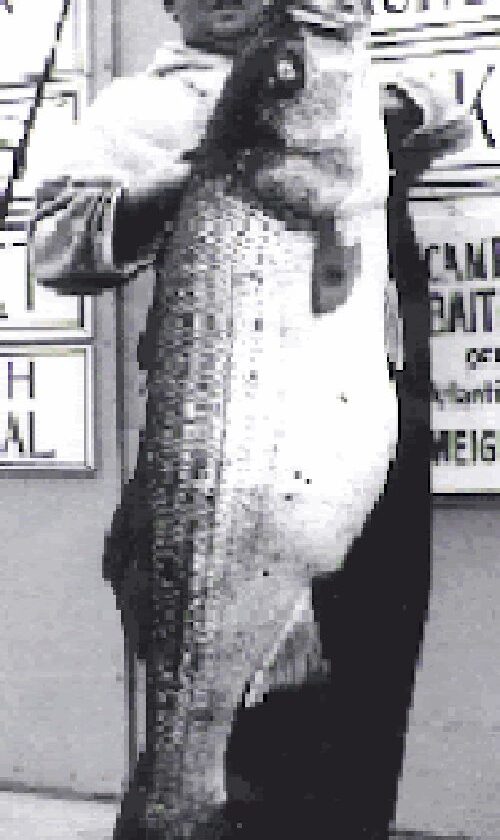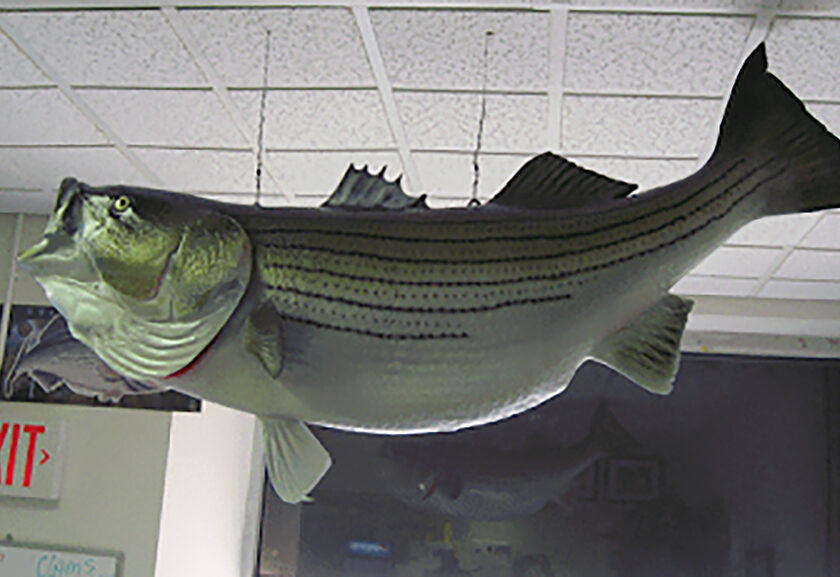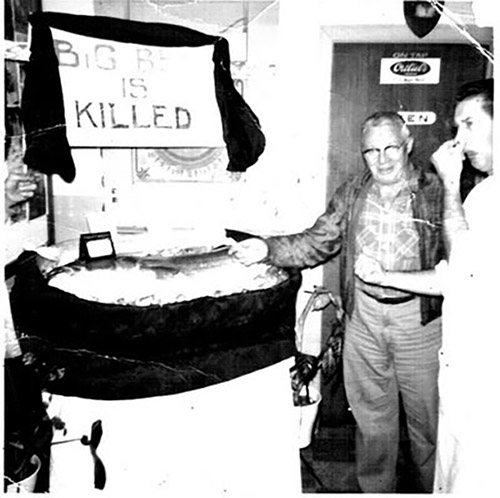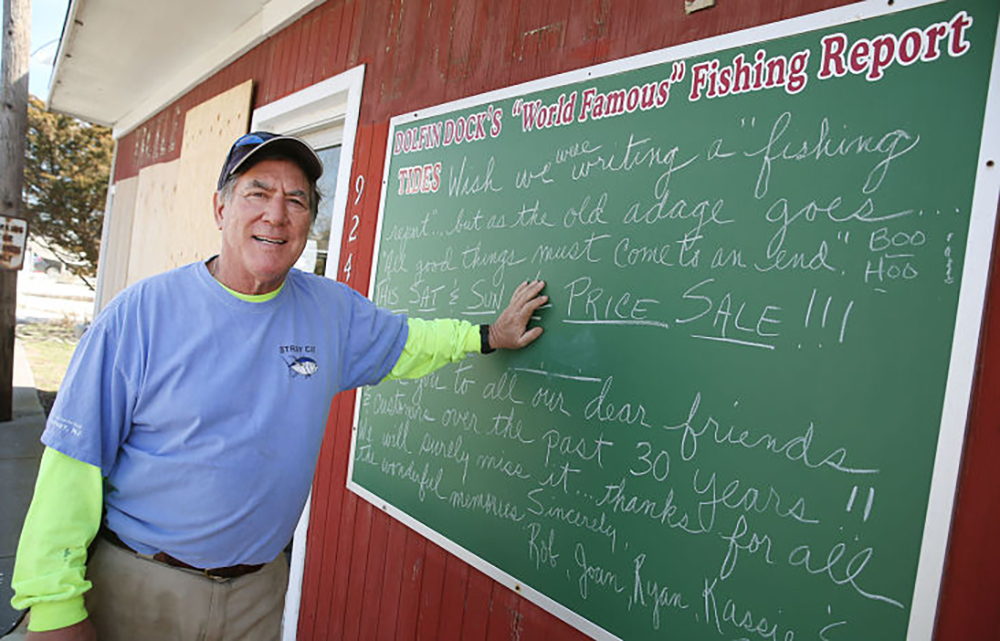By William Kelly
Native Americans would have looked at the prevalence of striped bass as a good omen, like the return of the bald eagle, black bear, dolphins and whales.
They ate stripers at the first Thanksgiving and at the inaugural dinner when they opened the Flanders Hotel. Today it is considered the ultimate delicacy, if you can catch one, or know a fisherman who has caught one and is willing to part with a filet.
Striped bass have a unique place among local species of fish as they are considered hard to catch, good fighters and a fine eating fish, some say unparalleled.
The stripers are running now, so much so that the Atlantic States Marine Fisheries Commission on May 2 held an emergency meeting where they voted to amend the one-fish-per-day limit to a 28 inches minimum and less than 31 inches length maximum on recreational striped bass fishing. Anything greater than 31 or less than 28 inches must go back in the water. The new upper limit is down from 38 inches.

The rule change takes effect July 2 and will stay in effect for 180 days when it will be reviewed. The action passed with only one dissension, that from the New Jersey representative.
The commission’s press release states that, “This action responds to the unprecedented magnitude of the 2022 recreational harvest, which is nearly double that of 2021.”
And it appears to be a trend continuing this season. A quick survey of some experienced local fishermen confirmed that stripers are running and plentiful, if you know where, when and how to catch them.
Michael Waine, Atlantic Fisheries policy director of the American Sportfishing Association said, “The board has signaled they are ready to be very conservative on striped bass management, using emergency action to enact regulations without a plan to implement a mid-year change.
“We know that something has to be done to reduce mortality. ASA is committed to working with industry and conservation groups to reduce mortality through education and messaging.”
Some people like to fish while sitting out in the sun with a cold drink and a line in the water. Then there are those who like catching fish, and for the most part, they like catching stripers, manage their days according to the tide chart, know what bait to use and have a favorite spot to catch fish.

Rob Barrett owned Dolfin Dock on Bay Avenue in Somers Point for many years, and used to scrawl the daily fishing report on a blackboard in front of his shop.
When asked what he would write today he said: “Fluke are as thick as shingles on a roof, hot spots off Kennedy Park, Ocean City airport and the Parkway Bridge. Killer minnows with a strip of lucky squid top baits. Stirpers up river.”
Barrett said a man from Northfield, Adam Gicsas, caught seven keeper stripers in as many weeks. Gicsas, 23, said he likes to fish for stripers because “they’re a fun fight.”
While he goes up river towards Mays Landing, he edits out the surroundings from pictures of the fish he has caught as not give away the location of his secret fishing spot.
Gicsas said he uses bloodworms he buys at the Tight Line Bait and Tackle Shop on Bay Avenue in Somers Point, where the worms go for $17 a dozen, though owner Chris Baliban said he is also selling a lot of bunker, clams and especially eels, a few thousand in one week. Baliban also has a nice weigh station on the back deck and puts pictures of the catches on his website.
Another avid fisherman, Billy Heiro, put his boat in the water and went fishing for fluke on opening day, but caught a 32-inch keeper striper instead. “The stripers are out there and plentiful,” Heiro said.
This area has a reputation for striper fishing, dating back to the early 1960s when Murray Upperman of Margate caught a world record at that time, 62-pound, 9-ounce striper in Elmer Gregory’s boat off Island Beach State Park, using one of his own Upperman White Tail lures. Upperman’s lures were so successful that during World War II the Navy included one in every pilot’s survival kit.
They called the fish “Big Ben,” and held a wake at Gregory’s Bar where the fish was put on display, and later mounted above the door to the dining room.
There was a measured decline in the striper catch from the 1960s through the 1980s, when the Marine Fisheries Commission made efforts to sustain the species.
Then in the middle of a raging nor’easter in September 1982, Atlantic City lifeguard Albert McReynolds went fishing on the Atlantic City Inlet jetty, knowing the storm would bring the big ones in close. Sure enough he caught two stripers that night, leaving a 40-pounder flopping on the rocks while he reeled in a world-record 78-pound, 8-ouncer, at 53 inches in length. McReynolds got a hefty reward from the company that made the line he used, and he went to Florida where he caught a world-record shark.
McReynolds’ record has since been eclipsed by Greg Myerson who caught his 81-pound, 14-ounce striper off his boat in the Patchogue River near Westbrook, Conn. in 2011. There are even bigger stripers out there, as commercial fishermen have netted and returned fish that weighed in over 100 pounds.
There has always been attempts by commercial fishermen to include stripers in their legal catch, but sports fishermen have kept the striper a sports fish. When Dick Russell documented the story in his book “Striper Wars” (2006, Island Press), he visited Gregory’s and gave a slide show lecture in the dining room where the plastic mounts of both Upperman’s and McReynolds’ trophy fish were put on display.
The big ones, however, are not as tasty as the mid-range stripers that are so plentiful now that they are tightening the size limits. The rule change has its critics.
Rob Barrett said: “It’s really bad for the bait shop business, and increases injury in released fish: a lose, lose situation.”

Chris Baliban, at Tight Lines said there’s nothing that can be done about it.
“I mean a lot of fishermen are up in arms about it, but I don’t think it’s the end of the world. I don’t like it, but it’s what we are dealing with. The whole world is that way.”
Baliban said that if such measures aren’t taken to preserve the species, it could get worse and they could move toward using only artificial lures or even making the striper strictly a catch-and-release fish.
Greg Gregory, who likes catching stripers, was fishing off boats in the Chesapeake last week, ran the Somers Point Bayfest and then went fishing on Raritan Bay this week, and serves as chairman of the Great Egg Harbor River Council of the National Park system. He said he’s all for the new regulations.
“I am for the limiting and release of the big breeder cows; old, old fish full of eggs that you can’t eat, so they will replenish the stock for the future,” he said.
Gregory remembers back in the 1970s when stripers were scarce. He caught a 28-incher off the bridge, and it won three size records that season.
Now they are catching more than ever, though Gregory questions the doubling in the amount of recreational catches last season compared to the previous year. He believes there are more catches being reported, so it might not be a valid statistic.
There is no doubt, however, that the stripers are running, and there’s plenty of them if you know how to catch them.
While you can’t buy striper fish at the fish market or in a restaurant, they are good eating if you catch one or know someone who has caught one. They have the texture of a filet mignon steak you can cut with a fork.
The best way to cook a fresh striper is to bake or pan fry in butter, or if it is a few days old, sprinkle a little parmesan cheese on it before cooking.






